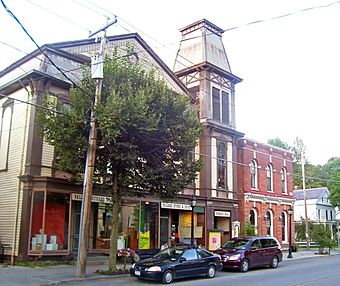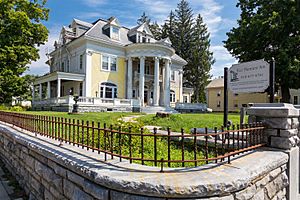Cambridge Historic District (Cambridge, New York) facts for kids
Quick facts for kids |
|
|
Cambridge Historic District
|
|

Hubbard Hall, south elevation, 2008
|
|
| Location | Cambridge, NY |
|---|---|
| Nearest city | Bennington, VT |
| Area | 105 acres (42 ha) |
| Built | 19th century |
| Architectural style | Federal, Greek Revival, late Victorian |
| NRHP reference No. | 78001922 |
| Added to NRHP | 1978 |
The Cambridge Historic District is a special area in the village of Cambridge, located in Washington County, New York. It covers about 105 acres (42 hectares). This district shows how the village looked when it first became an official village in the 1860s. It also shows how it grew when the Rice Seed Company, which was once the biggest seed company in the world, was here.
Many of the 240 buildings in the district are from the 1800s. A few are even older, from the 1700s. Some newer buildings are also mixed in. Important buildings here include the old Rice Seed Company office, a beautiful opera house from the late 1800s, and a church with special Tiffany designs and stained glass windows. In 1978, this area was named a historic district. It was then added to the National Register of Historic Places, which is a list of important historical places in the United States.
Contents
Exploring the District's Layout
The Cambridge Historic District is built around its main streets. These include East and West Main Streets, and North and South Union Streets. Some buildings on nearby cross streets are also part of the district.
The land here is mostly flat. This is because of the nearby Owl Kill, a small stream that flows through the district. The old tracks of the Delaware and Hudson Railroad also run through the area. Most buildings are wooden houses.
You'll find many shops and businesses on West Main Street. There are also homes and a few churches. Some newer buildings, like a gas station or a supermarket, are also in the district. These newer buildings don't quite fit the old style, but they are still part of the area.
A Look Back in Time: Cambridge's History
People started settling in this area in the 1760s. This was after the French and Indian War ended, making it safe to live north of Albany. In 1761, a man named Cadwallader Colden helped buy a large piece of land called the Cambridge Patent. This land was set up so that landowners could elect their own leaders. It also made sure that families could own their land. This helped create a fair society where people had freedom.
The area was good for farming because it had flat land near the Owl Kill. Many early settlers came from Scotland and Northern Ireland. This is why Presbyterian churches became popular early on.
After the American Revolution, more people moved here. The oldest house still standing in the district is the Dorr-Randall House. It was built in 1779 on East Main Street. This house shows the popular Federal style of architecture from that time. An academy, which was a type of school, was started in 1800. Its old boarding house is now apartments.
As the 1800s continued, three small settlements grew in the area. They were Cambridge, Dorr Corners, and North White Creek. Early roads connected them to markets in places like Troy and Burlington. Farmers started raising flax and sheep. These provided materials for textile mills in nearby towns.
The Champlain Canal opened in 1825. This canal helped the economy grow even more. Two new churches were built: a Methodist church in 1838 and a Baptist church in 1844.
In 1852, the Troy and Rutland Railroad came through the town. A train station was built in North White Creek. Fourteen years later, in 1866, the three settlements decided to join together. This is how the village of Cambridge was formed. This is also why some of the village's streets still meet at unusual angles today.
The years after the merger were the village's best economic times. Many of the houses built then show the popular styles of the mid-1800s. St. Luke's Church was built in 1866. It has beautiful Tiffany artwork and windows inside. The railroad also brought new businesses. Hubbard Hall, a large building for theater, was built in 1878.
The biggest reason for growth was the Rice Seed Company. Its main office opened in the village in 1879. The company's warehouse and office building were finished in 1895. The founder, Jerome Rice, lived across the street. By the early 1900s, Rice was the largest seed company in the world! It employed 200 people in Cambridge.
However, things changed in the 20th century. The canal became less busy. A new highway, the Adirondack Northway, opened in the mid-1900s. This highway took over as the main way to transport goods. The Rice Seed Company closed in 1976.
Important Buildings to See
- Dorr-Randall House, 151 East Main Street. This house was built in 1779 for a well-known doctor. Its detailed carved designs show that the owner was wealthy for that time. It's one of the best examples of the Federal style in the county.
- Hubbard Hall, also called the Old Opera House, 25 West Main Street. This is a major landmark in Cambridge. This Second Empire style building was built in 1878 for plays and shows. It is still used today as a cultural center.
- Rice Seed Company Warehouse and Office Building, 15 West Main Street. This company was Cambridge's biggest employer in the late 1800s. The warehouse was built in 1879, and the office in 1895.
- St. Luke's Church, 4 St. Luke's Place. This church was built in 1866. It has amazing Tiffany artwork and windows inside.
Keeping History Alive
Unlike some other towns, Cambridge does not have special rules in its local laws to protect the historic district. There isn't a separate group in charge of this task. However, in 2009, the village updated its rules. These new rules recognize different types of homes and plan for a future historic area.




